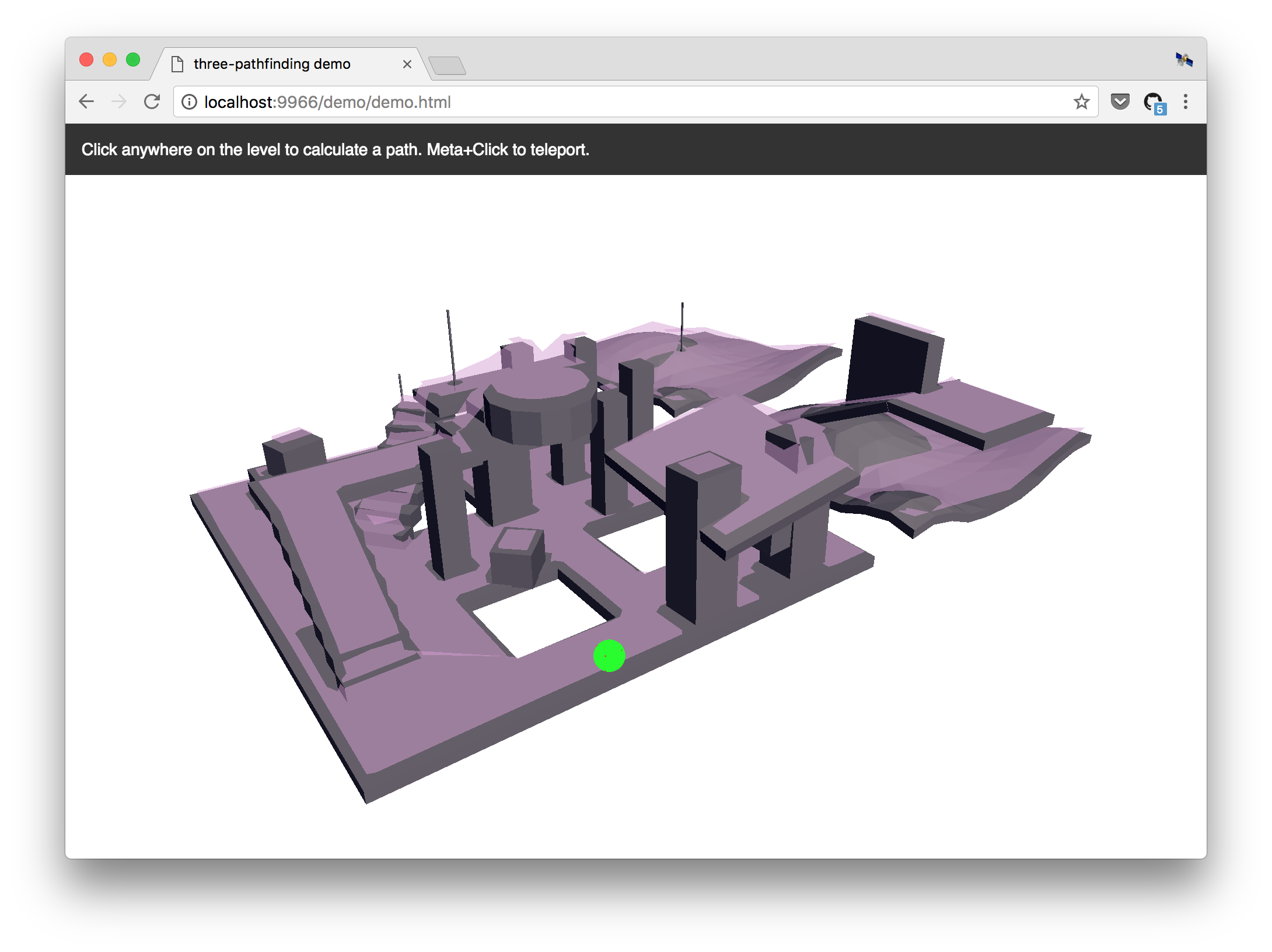
Security News
Fluent Assertions Faces Backlash After Abandoning Open Source Licensing
Fluent Assertions is facing backlash after dropping the Apache license for a commercial model, leaving users blindsided and questioning contributor rights.
three-pathfinding
Advanced tools
Navigation mesh toolkit for ThreeJS, based on PatrolJS. Computes paths between points on a 3D nav mesh, supports multiple zones, and clamps movement vectors for FPS controls. To learn how to create a navigation mesh using Blender, see Creating a Nav Mesh.
Thanks to Nick Janssen for creating PatrolJS, which was the basis for this library.

Traditionally games and 3D apps used waypoints to help their AI agents navigate. This is bad and has a lot of problems, but is generally easier to implement than navigation meshes. Navmeshes are far more accurate, faster, and take into account the size of the AI agent (e.g. tanks require move space to maneuver than soldiers).
For a thorough introduction to Navigation mesh pathfinding, see AI Blog's article, Fixing Pathfinding Once and For All.
npm install --save three-pathfinding
This library does not build navigation meshes for you — instead, create a navigation mesh using Blender, Recast (CLI), or another tool.
Currently, this library does not accept the custom navigation mesh file formats created by tools like Recast. Instead, you will need to export the navigation mesh to a 3D model format (like OBJ or glTF) and then load it with one of the three.js loaders, like THREE.OBJLoader or THREE.GLTFLoader. The library accepts a THREE.BufferGeometry instance, and follows the +Y=Up convention of three.js and glTF.
Loading a mesh from a .gltf file:
// For ES6, see: https://github.com/mrdoob/three.js/issues/9562
// CommonJS
const THREE = window.THREE = require('three');
require('three/examples/js/loaders/GLTFLoader.js');
let navmesh;
const loader = new THREE.GLTFLoader();
loader.load( 'navmesh.gltf', ({scene}) => {
scene.traverse((node) => {
if (node.isMesh) navmesh = node;
});
}, undefined, (e) => {
console.error(e);
});
Initializing the library, creating a level, and finding a path:
// ES6
import { Pathfinding } from 'three-pathfinding';
// CommonJS
const { Pathfinding } = require('three-pathfinding');
// UMD
const Pathfinding = window.threePathfinding.Pathfinding;
// Create level.
const pathfinding = new Pathfinding();
const ZONE = 'level1';
pathfinding.setZoneData(ZONE, Pathfinding.createZone(navmesh.geometry));
// Find path from A to B.
const groupID = pathfinding.getGroup(ZONE, a);
const path = pathfinding.findPath(a, b, ZONE, groupID);
The origin of an agent should initially be placed on the surface of the nav mesh. If needed, a dummy object can be used for pathfinding logic, and the rendered model for that agent may be placed at on offset as needed.
git clone https://github.com/donmccurdy/three-pathfinding.git
cd three-pathfinding
npm install
npm run dev
The demo will start at http://localhost:5000/demo/.
Defines an instance of the pathfinding module, with one or more zones.
Sets data for the given zone.
Returns a random node within a given range of a given position.
Returns Node
Returns the closest node to the target position.
Returns Node
Returns a path between given start and end points. If a complete path cannot be found, will return the nearest endpoint available.
startPosition Vector3 Start position.targetPosition Vector3 Destination.zoneID string ID of current zone.groupID number Current group ID.Returns Array<Vector3> Array of points defining the path.
Returns closest node group ID for given position.
zoneID stringposition Vector3Returns number
Clamps a step along the navmesh, given start and desired endpoint. May be used to constrain first-person / WASD controls.
start Vector3end Vector3 Desired endpoint.node NodezoneID stringgroupID numberendTarget Vector3 Updated endpoint.Returns Node Updated node.
(Static) Builds a zone/node set from navigation mesh geometry.
geometry BufferGeometrytolerance number Vertex welding tolerance. (optional, default 1e-4)Returns Zone
Extends Object3D
Helper for debugging pathfinding behavior.
path Array<Vector3>Returns this
position Vector3Returns this
position Vector3Returns this
position Vector3Returns this
position Vector3Returns this
Hides all markers.
Returns this
Defines a zone of interconnected groups on a navigation mesh.
Type: Object
Defines a group within a navigation mesh.
Type: Object
Defines a node (or polygon) within a group.
Type: Object
id numberneighbours Array<number> IDs of neighboring nodes.vertexIds Array<number>centroid Vector3portals Array<Array<number>> Array of portals, each defined by two vertex IDs.closed booleancost numberFAQs
Navigation mesh toolkit for three.js, based on PatrolJS
We found that three-pathfinding demonstrated a healthy version release cadence and project activity because the last version was released less than a year ago. It has 1 open source maintainer collaborating on the project.
Did you know?

Socket for GitHub automatically highlights issues in each pull request and monitors the health of all your open source dependencies. Discover the contents of your packages and block harmful activity before you install or update your dependencies.

Security News
Fluent Assertions is facing backlash after dropping the Apache license for a commercial model, leaving users blindsided and questioning contributor rights.

Research
Security News
Socket researchers uncover the risks of a malicious Python package targeting Discord developers.

Security News
The UK is proposing a bold ban on ransomware payments by public entities to disrupt cybercrime, protect critical services, and lead global cybersecurity efforts.